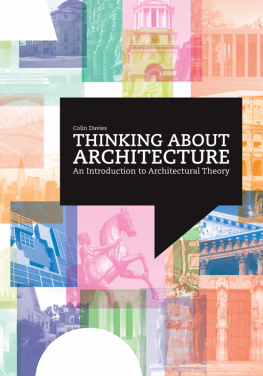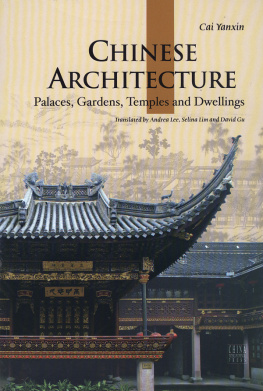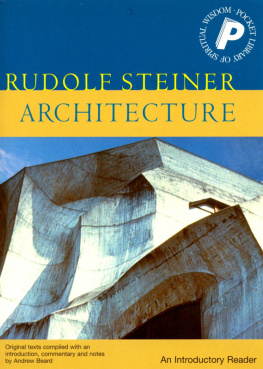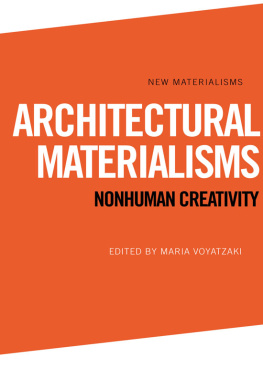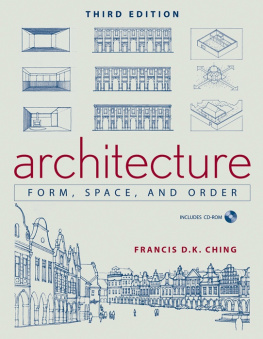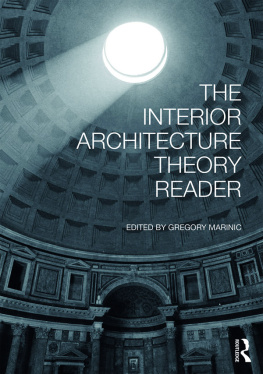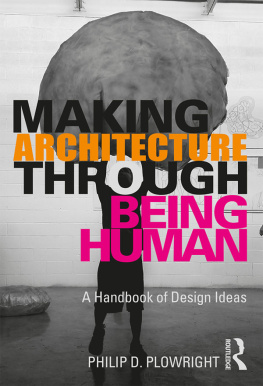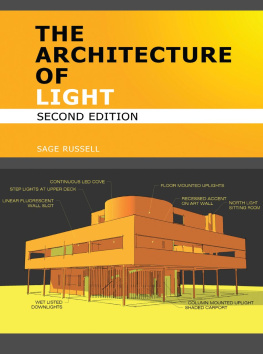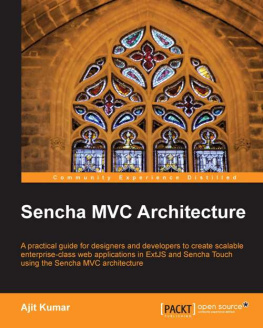THINKING ABOUT
ARCHITECTURE
An Introduction to Architectural Theory

Published in 2011
by Laurence King Publishing Ltd
361373 City Road
London EC1V 1LR
Tel: +44 (0)20 7841 6900
Fax: +44 (0)20 7841 6910
E-mail:
www.laurenceking.com
Design copyright 2011
Laurence King Publishing Limited
Text Colin Davies
Colin Davies has asserted his right under the Copyright, Designs and Patents Act 1988, to be identified as the Author of this work.
All rights reserved. No part of this publication may be reproduced or transmitted in any form or by any means, electronic or mechanical, including photocopy, recording, or any information storage and retrieval system, without prior permission in writing from the publisher.
A catalog record for this book is available from the British Library
ISBN 978 185669 755 2
Designed by Draught Associates
Printed in China
Colin Davies
THINKING ABOUT
ARCHITECTURE
An Introduction to Architectural Theory
Laurence King Publishing
PICTURE CREDITS
Front cover images, clockwise from top left: Hans A. Rosbach; G. Simpson; Steve Cadman; Christian Richters; Craig and Marie Mauzy; the author; Deror avi; Paul M. R. Maeyaert; Guillaume Piolle; Balasuramanian G. Velu; Sanchezn; the author; the author; Matthias Trischler; Jon; the author
Back cover images, clockwise from top left: Thermos; Scott Meltzer; Hans A. Rosbach; Jingu Administration Office; Manfred Brckels; Brad Feinknopf; Wouter Hagens; the author; Eric Parry Architects; Zaha Hadid Architects; the author; the author
Eredi Aldo Rossi. Courtesy Fondazione Aldo Rossi; Guillaume Piolle (Wikimedia Commons); 1415 Craig and Marie Mauzy, Athens; Thermos (Wikimedia Commons); Guillaume Piolle (Wikimedia Commons); the author; Deror avi (Wikimedia Commons); Courtesy of Zaha Hadid Architects; 26l the author; 26r Sangwine (Wikimedia Commons); 2930 the author; Richard Bryant/Arcaid; Laurence King Publishing; 34t Michael Fazio; 34b the author; Paul M. R. Maeyaert; Brad Feinknopf (Wikimedia Commons); Laurence King Publishing; the author; Courtesy of Zaha Hadid Architects; Eric Parry Architects; Courtesy Jingu Administration Office; 2011, The Frank Lloyd Wright Fdn, AZ/Art Resource, NY/Scala, Florence/ARS, NY and DACS, London 2011; Stephen Perrella and Rebecca Carpenter; Eric Parry Architects; Laurence King Publishing; the author; 51t Sanchezn (Wikimedia Commons); Laurence King Publishing; Quattrone, Florence; Illustration from Samuel Y. Edgerton Jr., The Renaissance Rediscovery of Linear Perspective, Basic Books, Inc., 1975; 57l Dicklyon (Wikimedia Commons); 57r Laurence King Publishing; Department of Education and Science; 59t Hans A. Rosbach (Wikimedia Commons); 59b FLC/ADAGP, Paris and DACS, London 2011; FLC/ADAGP, Paris and DACS, London 2011; RIA Novosti/TopFoto; Quattrone, Florence; 65t Quattrone, Florence; 65c Wikimedia Commons; 65b Wikimedia Commons; Robert Holden; 70t DACS, London 2011; 70b Josef Lehmkuhl (Wikimedia Commons)/DACS 2011; 72l Stemonitis (Wikimedia Commons); 72r by Steve Cadman on Flickr; 73l Locutus Borg (Wikimedia Commons); Steve Cadman (Wikimedia Commons); 75t Illinois State Penitentiary/Mary Evans/Peter Higginbotham Collection; 75b Manfred Brckels (Wikimedia Commons); Laurence King Publishing; 78t iStockphoto; 78b the author; RIA Novosti/TopFoto; Illustration from The Manhattan Transcripts, Bernard Tschumi, Academy Editions, 1994; Ken Kirkwood; Balasubramanian G. Velu (Wikimedia Commons); the author; Ken Kirkwood; the author; 89r Simdaperce (Wikimedia Commons); 93l Paul M. R. Maeyaert; 93r Alexander Noski (Wikimedia Commons); 94t Wikimedia Commons; 94b the author; Steve Cadman (Wikimedia Commons); 96tl Myrabella (Wikimedia Commons); 96tr T. Taylor (Wikimedia Commons); 96b G. Simpson (Wikimedia Commons); 98l Max Hermus (Wikimedia Commons); 98r the author; 99t Christian Richters; 99b Immanuel Giel (Wikimedia Commons); the author; Scott Meltzer (Wikimedia Commons); the author; Paul M. R. Maeyaert/DACS 2011; 104t&c Richard Weston; 104b Jones2jy (Wikimedia Commons); Paul M. R. Maeyaert; 106t the author; 106b Hans A. Rosbach (Wikimedia Commons); Richard Weston/ARS, NY and DACS, London 2011; Photograph from Bernard Rudofsky, Architecture without Architects: A Short Introduction to Non-pedigreed Architecture, Museum of Modern Art, 1964; Jon (Wikimedia Commons); Illustration from DArcy Wentworth Thompson, On Growth and Form, Cambridge University Press, 1961; 118l the author; Paolo (Wikimedia Commons); Courtesy of Zaha Hadid Architects; Jmex60 (Wikimedia Commons); Wouter Hagens (Wikimedia Commons); Laurence King Publishing; Hans Muenchhalfen/artur; Matthias Trischler (Wikimedia Commons); the author; Matthew G. Bisanz (Wikimedia Commons); Wouter Hagens (Wikimedia Commons); Martin G. Conde (Wikimedia Commons); 140t&c the author; 140b Lalupa (Wikimedia Commons); 143b FLC/ADAGP, Paris and DACS, London 2011; FLC/ADAGP, Paris and DACS, London 2011; Illustration from Lon Krier: Drawings, 19671980; Peter Morgan (Wikimedia Commons); 148t Myriam Thyes (Wikimedia Commons); 148b Nino Barbieri (Wikimedia Commons)
INTRODUCTION
Theory stuck close to practice, which seemed the only way to justify its existence. By the mid-1960s those modernist ideas had become an orthodoxy and were already beginning to seem a little stale. Teachers and writers on the fringe of the profession began to ask if architecture really was just about problem-solving and the updating of the building industry. In Italy, for example, Aldo Rossi sought to restore respect for the premodern European city in his book Larchitettura della citt, first published in 1966 (published in English as The Architecture of the City in 1982) and Manfredo Tafuri brought Marxist theory to bear on architecture in his book Progetto e Utopia, first published in 1973 (published in English as Architecture and Utopia in 1976). Meanwhile, in America, Robert Venturis Complexity and Contradiction in Architecture (1966) laid the foundation for a new post-modernist critique, and the MIT-based magazine Oppositions began to publish decidedly intellectual articles by architect/thinkers like Peter Eisenman, Colin Rowe, and Alan Colquhoun.
Two distinct philosophical strands began to emerge: a phenomenological approach, typified by the popularity among architects, teachers and students of a book called The Poetics of Space by the French philosopher Gaston Bachelard, and the revival of an old idea: that architecture might be thought of as a kind of language. At about this time, controversy was raging in the English departments of universities about a new approach to literary criticism that went by the name of Structuralism. Structuralism came from France and before long French People began to specialize in it and not all of them were architects. The link between practice and theory weakened. Theory was now seen mainly as a form of criticism, not just of individual buildings but of the city as a whole and of the relationship between architecture and modern life. It began to float free, developing its own language, its own kind of writing, its own store of ideas. It became a kind of miniature economy, producing books, articles, and paper projects for consumption by a small group of specialist postgraduate students who then went on to produce more books, articles, and paper projects.
Next page
